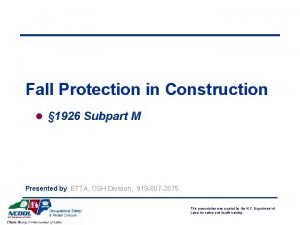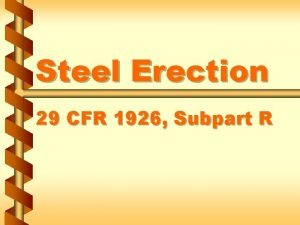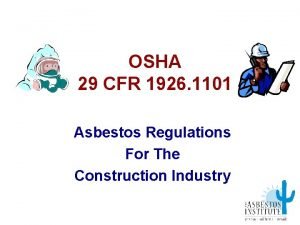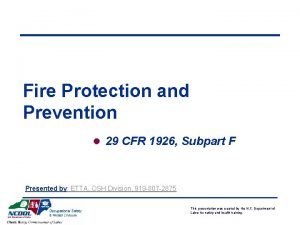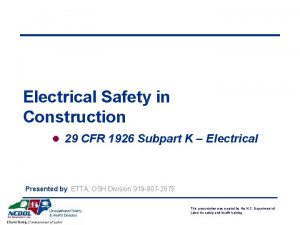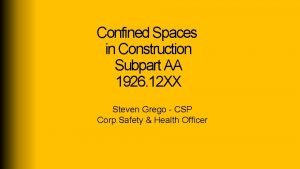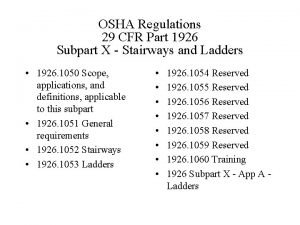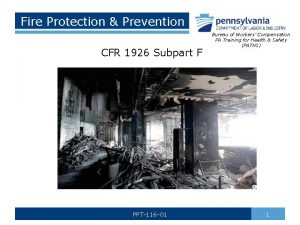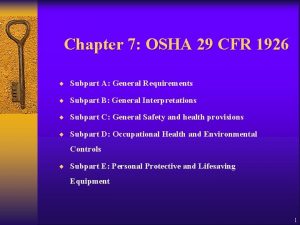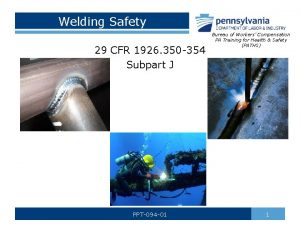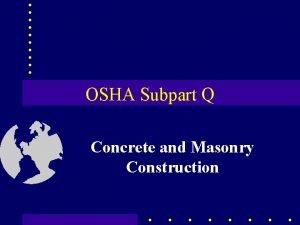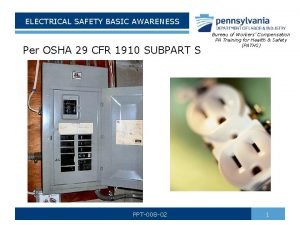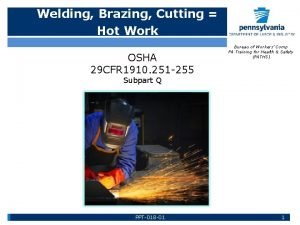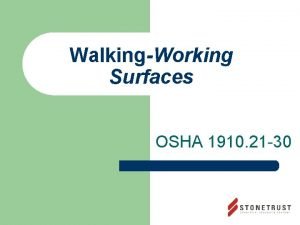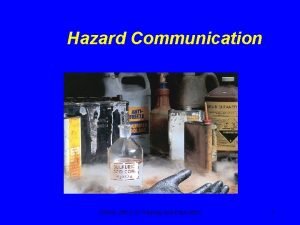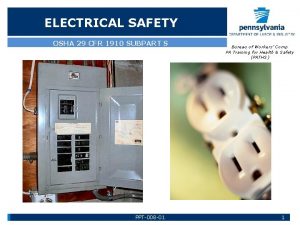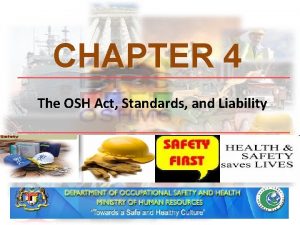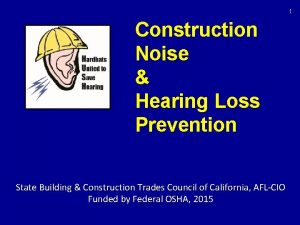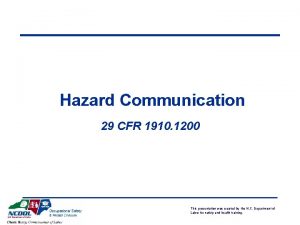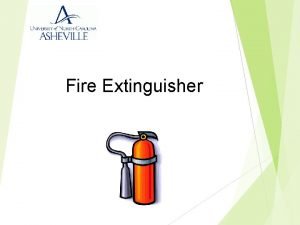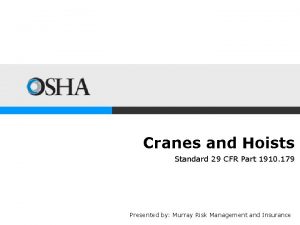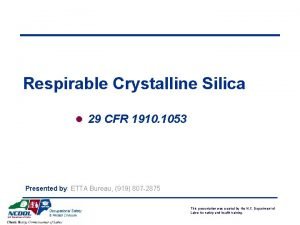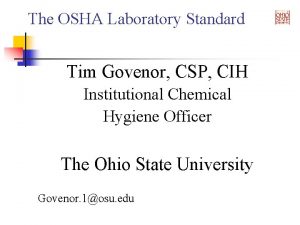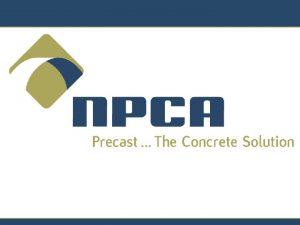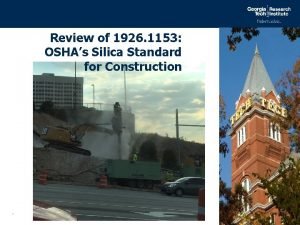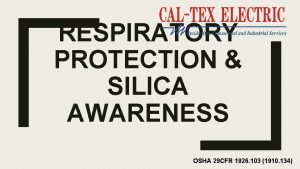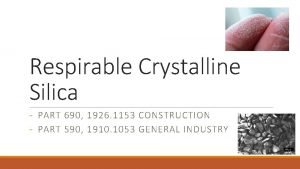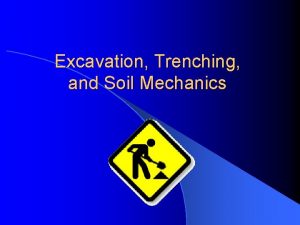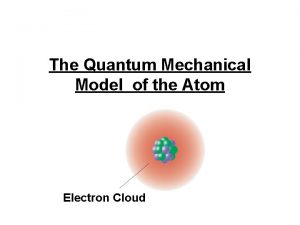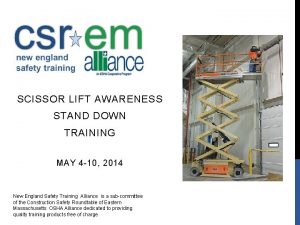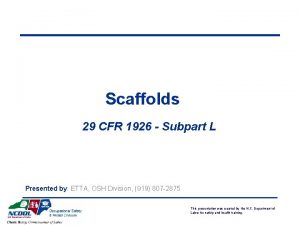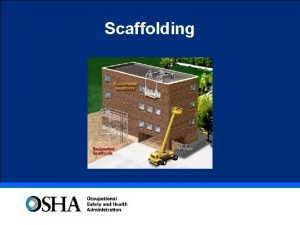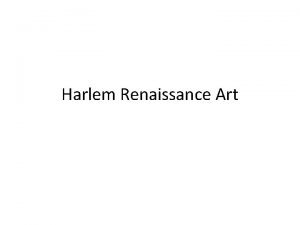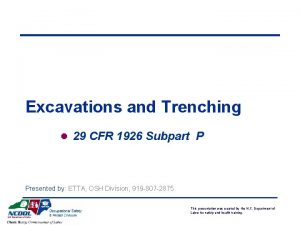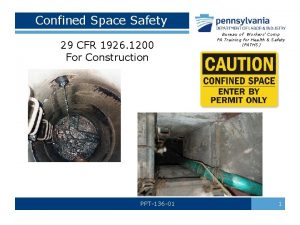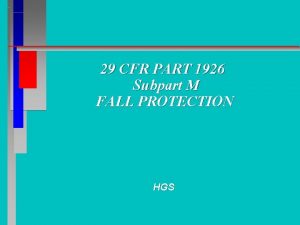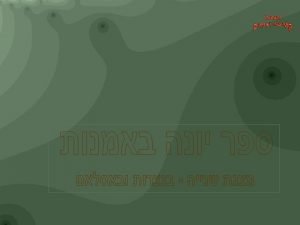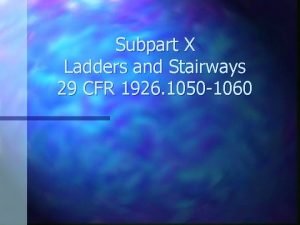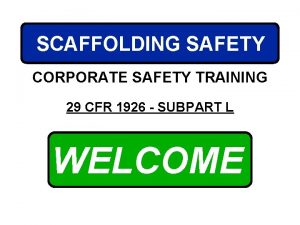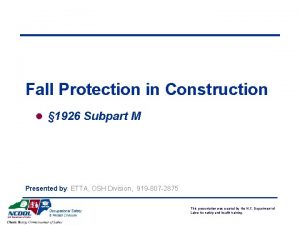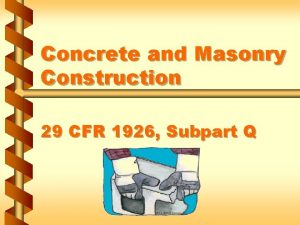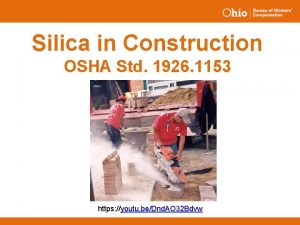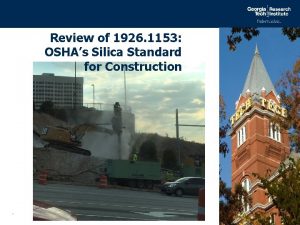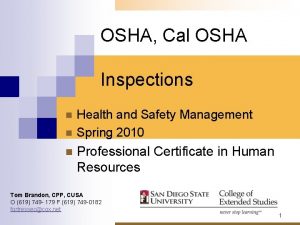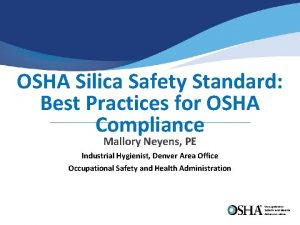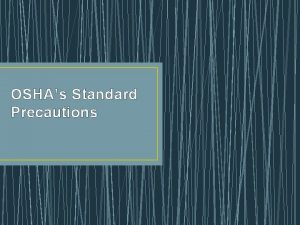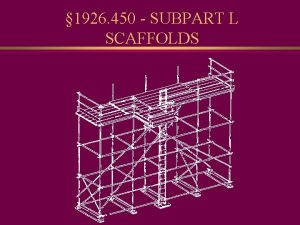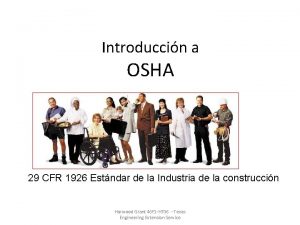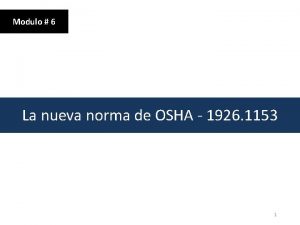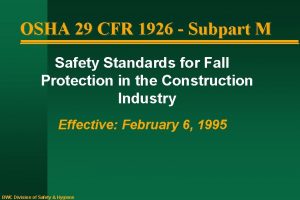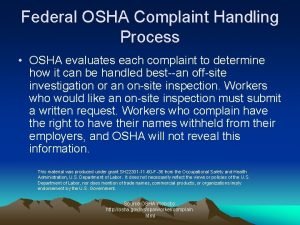Module 6 The New OSHA Standard 1926 1153






















































- Slides: 54

Module # 6 The New OSHA Standard - 1926. 1153 1

Disclaimer This material was produced under grant number SH-05053 -SH 8 from the Occupational Safety and Health Administration, U. S. Department of Labor. It does not necessarily reflect the views or policies of the U. S. Department of Labor, nor does mention of trade names, commercial products, or organizations imply endorsement by the U. S. Government. 2

Number of Deaths Number of silicosis deaths, United States, 2001– 2010 200 180 160 140 120 100 80 60 40 2001 Silicosis IS NOT CURABLE, but it IS PREVENTABLE. 2002 2003 2004 2005 < 44 2006 2007 2008 2009 2010 ≥ 45 3

Scope and Application 1926. 1153 (a) • The standard applies to all occupational exposures to respirable crystalline silica in construction work, except where employee exposure is below the action level [25 micrograms per cubic meter of air (25 μg/m 3)] as an 8 -hour time-weighted average (TWA) under any foreseeable conditions. 4

What to Expect at Work (1) The new standard aim is to limit worker exposures to respirable crystalline silica. The standard provides flexible alternatives, which OSHA expects will be especially useful for small employers. Employers can either use: – Specified exposure and control methods [1926. 1153 (c)] that illustrated in Table 1. • Table 1 Lists 18 tasks with engineering and work practice control methods, and respirator requirements – Alternative exposure control methods [1926. 1153 (d)] • For tasks not listed in Table 1; or • Where the employer does not fully and properly implement the engineering controls, work practices, and respiratory protection described in Table 1 5

What to Expect at Work (2) Regardless of which exposure control method is used, all construction employers covered by the standard are required to: • Establish and implement a written exposure control plan • Designate a competent person to implement the written exposure control plan. • Restrict housekeeping practices • Offer medical exams-including chest X-rays and lung function tests-every three years for workers who are required by the standard to wear a respirator for 30 or more days per year. • Train workers on work operations that result in silica exposure and ways to limit exposure. • Keep records of exposure measurements, objective data, and medical exams. 6

Specified Exposure and Control Methods 1926. 1153 (c) • Table 1 is a list of 18 tasks and what precautions need to be taken when performing them. – The amount of time spent on a task may effect the respiratory protection needed – Being indoor or outdoor may also effect what respiratory protection needed 7

Specified Exposure and Control Methods (1) Equipment/task (i) Stationary masonry saws (ii) Handheld power saws (any blade diameter) Engineering and work practice control methods Use saw equipped with integrated water delivery system that continuously feeds water to the blade Operate and maintain tool in accordance with manufacturer's instructions to minimize dust emissions: -When used outdoors -When used indoors or in an enclosed area (iii) Handheld power saws for For tasks performed outdoors only: cutting fiber-cement board • Use saw equipped with commercially available dust collection (with blade diameter of 8 inches system or less) • Operate and maintain tool in accordance with manufacturer's instructions to minimize dust emissions Dust collector must provide the air flow recommended by the tool manufacturer, or greater, and have a filter with 99% or greater efficiency Required respiratory protection and minimum assigned protection factor (APF) ≤ 4 hours/shift >4 hours/shift None APF 10 None 8

Stationary masonry saw Handheld power saw Saw for fiber cement board Specified exposure and control methods (Table 1 -1) Visual Examples (1) 9

Specified Exposure and Control Methods (2) Equipment/task (iv) Walk-behind saws (v) Drivable saws Engineering and work practice control methods Use saw equipped with integrated water delivery system that continuously feeds water to the blade Operate and maintain tool in accordance with manufacturer's instructions to minimize dust emissions: -When used outdoors -When used indoors or in an enclosed area For tasks performed outdoors only: • Use saw equipped with commercially available dust collection system • Operate and maintain tool in accordance with manufacturer's instructions to minimize dust emissions (vi) Rig-mounted core saws Use tool equipped with integrated water delivery system that or drills supplies water to cutting surface Operate and maintain tool in accordance with manufacturer's instructions to minimize dust emissions Required respiratory protection and minimum assigned protection factor (APF) ≤ 4 hours/shift >4 hours/shift None APF 10 None 10

Walk behind saw Drivable saw Rig mounted core saw Specified exposure and control methods (Table 1 -2) Visual Examples (2) 11

Specified Exposure and Control Methods (3) Equipment/task (vii) Handheld and standmounted drills (including impact and rotary hammer drills) Engineering and work practice control methods Use drill equipped with commercially available shroud or cowling with dust collection system Operate and maintain tool in accordance with manufacturer's instructions to minimize dust emissions Dust collector must provide the air flow recommended by the tool manufacturer, or greater, and have a filter with 99% or greater efficiency and a filter-cleaning mechanism Use a HEPA-filtered vacuum when cleaning holes (viii) Dowel drilling rigs for For tasks performed outdoors only: concrete Use shroud around drill bit with a dust collection system. Dust collector must have a filter with 99% or greater efficiency and a filter-cleaning mechanism (ix) Vehicle-mounted Use dust collection system with close capture hood or shroud drilling rigs for rock and around drill bit with a low-flow water spray to wet the dust at concrete the discharge point from the dust collector Or Operate from within an enclosed cab and use water for dust suppression on drill bit Required respiratory protection and minimum assigned protection factor (APF) ≤ 4 hours/shift >4 hours/shift None APF 10 None 12

Handheld drill Dowell drilling rig Vehicle mounted drill rig Specified exposure and control methods (Table 1 -3) Visual Examples (3) 13

Specified Exposure and Control Methods (4) Equipment/task (x) Jackhammers and handheld powered chipping tools Engineering and work practice control methods Use tool with water delivery system that supplies a continuous stream or spray of water at the point of impact: When used outdoors When used indoors or in an enclosed area Required respiratory protection and minimum assigned protection factor (APF) ≤ 4 hours/shift >4 hours/shift None APF 10 None APF 10 14 APF 10 Or Use tool equipped with commercially available shroud and dust collection system. • Operate and maintain tool in accordance with manufacturer's instructions to minimize dust emissions. • Dust collector must provide the air flow recommended by the tool manufacturer, or greater, and have a filter with 99% or greater efficiency and a filter-cleaning mechanism: When used outdoors When used indoors or in an enclosed area

Handheld power chipping tool Specified exposure and control methods (Table 1 -4) Visual Examples (4) 15

Specified Exposure and Control Methods (5) Equipment/task Engineering and work practice control methods (xi) Handheld grinders Use grinder equipped with commercially available shroud and for mortar removal (i. e. , dust collection system. • Operate and maintain tool in accordance with tuckpointing) manufacturer's instructions to minimize dust emissions • Dust collector must provide 25 cubic feet per minute (cfm) or greater of airflow per inch of wheel diameter and have a filter with 99% or greater efficiency and a cyclonic pre-separator or filter-cleaning mechanism Required respiratory protection and minimum assigned protection factor (APF) ≤ 4 hours/shift >4 hours/shift APF 10 APF 25 16

Handheld grinders for mortar removal Specified exposure and control methods (Table 1 -5) Visual Examples (5) 17

Specified Exposure and Control Methods (6) Equipment/task Engineering and work practice control methods Required respiratory protection and minimum assigned protection factor (APF) ≤ 4 hours/shift >4 hours/shift (xii) Handheld grinders for For tasks performed outdoors only: uses other than mortar • Use grinder equipped with integrated water delivery removal system that continuously feeds water to the grinding • surface Operate and maintain tool in accordance with manufacturer's instructions to minimize dust emissions None Or Use grinder equipped with commercially available shroud and dust collection system. • Operate and maintain tool in accordance with manufacturer's instructions to minimize dust emission. • Dust collector must provide 25 cubic feet per minute (cfm) or greater of airflow per inch of wheel diameter and have a filter with 99% or greater efficiency and a cyclonic pre-separator or filter-cleaning mechanism: When used outdoors When used indoors or in an enclosed area None APF 10 18

Handheld grinder Specified exposure and control methods (Table 1 -6) Visual Examples (6) 19

Specified Exposure and Control Methods (7) Equipment/task Engineering and work practice control methods Required respiratory protection and minimum assigned protection factor (APF) ≤ 4 hours/shift >4 hours/shift (xiii) Walk-behind milling Use machine equipped with integrated water delivery machines and floor grinders system that continuously feeds water to the cutting surface. • Operate and maintain tool in accordance with manufacturer's instructions to minimize dust emissions None Or Use machine equipped with dust collection system recommended by the manufacturer. • Operate and maintain tool in accordance with manufacturer's instructions to minimize dust emission. • Dust collector must provide the air flow recommended by the manufacturer, or greater, and have a filter with 99% or greater efficiency and a filter-cleaning mechanism • When used indoors or in an enclosed area, use a HEPA-filtered vacuum to remove loose dust in between passes 20

Floor grinder Specified exposure and control methods (Table 1 -7) Visual Examples (7) 21

Specified Exposure and Control Methods (8) Equipment/task (xiv) Small drivable milling machines (less than half-lane) Engineering and work practice control methods Use a machine equipped with supplemental water sprays designed to suppress dust. Water must be combined with a surfactant. • Operate and maintain machine to minimize dust emissions Required respiratory protection and minimum assigned protection factor (APF) ≤ 4 hours/shift >4 hours/shift None Small drivable milling machine 22

Specified Exposure and Control Methods (9) Equipment/task (xv) Large drivable milling machines (half-lane and larger) Engineering and work practice control methods For cuts of any depth on asphalt only: • Use machine equipped with exhaust ventilation on drum enclosure and supplemental water sprays designed to suppress dust • Operate and maintain machine to minimize dust emissions Required respiratory protection and minimum assigned protection factor (APF) ≤ 4 hours/shift >4 hours/shift None None For cuts of four inches in depth or less on any substrate: • • Use machine equipped with exhaust ventilation on drum enclosure and supplemental water sprays designed to suppress dust Operate and maintain machine to minimize dust emissions Or Use a machine equipped with supplemental water spray designed to suppress dust. Water must be combined with a surfactant • Operate and maintain machine to minimize dust emissions 23

Large drivable milling machine Specified exposure and control methods (Table 1 -9) Visual Examples (9) 24

Specified Exposure and Control Methods (10) Equipment/task (xvi) Crushing machines Engineering and work practice control methods Required respiratory protection and minimum assigned protection factor (APF) ≤ 4 hours/shift >4 hours/shift Use equipment designed to deliver water spray or mist for dust suppression at crusher and other points where dust is generated (e. g. , hoppers, conveyers, sieves/sizing or vibrating components, and discharge points) • • Operate and maintain machine in accordance with manufacturer's instructions to minimize dust emissions Use a ventilated booth that provides fresh, climate-controlled air to the operator, or a remote control station (xvii) Heavy equipment and Operate equipment from within an enclosed cab When employees outside of the cab are engaged in the task, utility vehicles used to abrade or fracture silica- apply water and/or dust suppressants as necessary to containing materials (e. g. , minimize dust emissions hoe-ramming, rock ripping) or used during demolition activities involving silicacontaining materials None None 25

Crushing machine Heavy equipment for demo Specified exposure and control methods (Table 1 -10) Visual Examples (10) 26

Specified Exposure and Control Methods (11) Equipment/task (xviii) Heavy equipment and utility vehicles for tasks such as grading and excavating but not including: Demolishing, abrading, or fracturing silicacontaining materials Engineering and work practice control methods Apply water and/or dust suppressants as necessary to minimize dust emissions Or When the equipment operator is the only employee engaged in the task, operate equipment from within an enclosed cab Required respiratory protection and minimum assigned protection factor (APF) ≤ 4 hours/shift >4 hours/shift None Heavy equipment for grading 27

Table 1 Implementation (1) 1926. 1153 (c)(2) When implementing the control measures specified in Table 1, each employer shall: § Provide a means of exhaust as needed to minimize the accumulation of visible airborne dust for tasks performed indoors or in enclosed areas § Apply water at flow rates sufficient to minimize release of visible dust for tasks performed using wet methods 28

Table 1 Implementation (2) 1926. 1153 (c)(3) When an employee performs more than one task on Table 1 during the course of a shift, and the total duration of all tasks combined is more than four hours, the required respiratory protection for each task is the respiratory protection specified for more than four hours per shift. • If the total duration of all tasks on Table 1 combined is less than four hours, the required respiratory protection for each task is the respiratory protection specified for less than four hours per shift. 29

Alternative Exposure Control Methods 1926. 1153 (d) For tasks not listed in Table 1, or when the employer does not fully and properly implement the engineering controls, work practices, and respiratory protection described in Table 1: – The employer shall ensure that no employee is exposed to an airborne concentration of respirable crystalline silica in excess of permissible exposure limit (PEL) which is 50 μg/m 3. The PEL shall be calculated as an 8 -hour TWA. – The employer shall assess the exposure of each employee who is or may be exposed to silica at or above the action level utilizing one of the following methods: • Performance option • Scheduled monitoring option 30

Performance Option 1926. 1153 (d)(2)(ii) The employer shall assess the 8 -hour TWA exposure for each employee on the basis of any combination of air monitoring data or objective data sufficient to assess employee exposures to respirable crystalline silica. – Objective data means information such as air monitoring data from industrywide surveys, or calculations based on the composition of a substance demonstrating employee exposure to respirable crystalline silica associated with a particular product or material, or a specific process or task. • • To qualify as objective, the data must reflect workplace conditions closely resembling, or with a higher exposure potential than the processes, types of material, control methods, work practices, and environmental conditions present in the employer's current operations. Employers may use historical monitoring data as objective data if it meets these requirements. 31

Scheduled Monitoring Option (1) 1926. 1153 (d)(2)(iii) Requires both initial and periodic monitoring – Employers must perform initial monitoring as soon as work begins to determine exposure levels. – Employers must conduct periodic monitoring at specified intervals based on most recent monitoring result Initial monitoring must assess the 8 -hour TWA exposure for each employee on the basis of one or more personal breathing zone air samples that reflect the exposures of employees on each shift, for each job classification, in each work area. 32

Scheduled Monitoring Option (2) 1926. 1153 (d)(2)(iii) Where several employees perform the same tasks on the same shift and in the same work area, the employer may sample a representative fraction of these employees in order to meet this requirement. • In representative sampling, the employer shall sample the employee(s) who are expected to have the highest exposure to respirable crystalline silica. 33

Scheduled Monitoring Option (3) 1926. 1153 (d)(2)(iii) Employee exposures are below the action level: • The employer may discontinue monitoring for those employees whose exposures are represented by such monitoring. Employee exposures are at or above the action level but at or below the PEL: • The employer shall repeat such monitoring within six months of the most recent monitoring. Employee exposures are above the PEL: • The employer shall repeat such monitoring within three months of the most recent monitoring 34

Scheduled Monitoring Option (4) 1926. 1153 (d)(2)(iii)(E) Most recent (non-initial) exposure monitoring indicates that employee exposures are below the action level: The employer shall repeat such monitoring within six months of the most recent monitoring. Until two consecutive measurements, taken seven or more days apart, are below the action level, at which time the employer may discontinue monitoring. 35

Scheduled Monitoring Option (5) 1926. 1153 (d)(2)(iv) – Reassessment of exposures: The employer shall reassess exposures whenever a change in the production, process, control equipment, personnel, or work practices may reasonably be expected to result in new or additional exposures at or above the action level, or when the employer has any reason to believe that new or additional exposures at or above the action level have occurred 36

Scheduled Monitoring Option (6) 1926. 1153 (d)(2)(v) – Methods of sample analysis: The employer shall ensure that all samples taken to satisfy the monitoring requirements of paragraph (d)(2) of this section are evaluated by a laboratory that analyzes air samples for respirable crystalline silica in accordance with the procedures in Appendix A. • Appendix A specifies the procedures for analyzing air samples for respirable crystalline silica, as well as the quality control procedures. 37

Employee Notification 1926. 1153 (d)(2)(vi) – Within five working days after completing an exposure assessment in accordance with paragraph (d)(2) of this section, the employer shall individually notify each affected employee in writing of the results of that assessment or post the results in an appropriate location accessible to all affected employees. – Whenever an exposure assessment indicates that employee exposure is above the PEL, the employer shall describe in the written notification the corrective action being taken to reduce employee exposure to or below the PEL. 38

Observation of Monitoring 1926. 1153 (d)(2)(vii) – The employer shall provide affected employees or their designated representatives an opportunity to observe any monitoring of employee exposure to respirable crystalline silica. – The employer shall provide the observer with protective clothing and equipment at no cost and shall ensure that the observer uses such clothing and equipment. 39

Methods of Compliance 1926. 1153 (d)(3) Engineering and work practice controls – The employer shall use engineering and work practice controls to reduce and maintain employee exposure to respirable crystalline silica to or below the PEL, unless the employer can demonstrate that such controls are not feasible. Wherever such feasible engineering and work practice controls are not sufficient to reduce employee exposure to or below the PEL, the employer shall nonetheless use them to reduce employee exposure to the lowest feasible level and shall supplement them with the use of respiratory protection that complies with the requirements of paragraph (e) of this section. 40

Respiratory Protection (1) 1926. 1153 (e) 1. Where respiratory protection is required by this section, the employer must provide each employee an appropriate respirator that complies with the requirements of this paragraph and 29 CFR 1910. 134. Respiratory protection is required: • Where specified by Table 1 of paragraph (c) of this section; • For tasks not listed in Table 1, or where the employer does not fully and properly implement the engineering controls and work practices; • Where exposures exceed the PEL during periods necessary to install or implement feasible engineering and work practice controls; and • Where exposures exceed the PEL during tasks for which engineering and work practice controls are not feasible or not sufficient to reduce the exposures below PEL. 41

Respiratory Protection (2) 1926. 1153 (e) 2. Respiratory protection program. Where respirator use is required by this section, the employer shall institute a respiratory protection program in accordance with 29 CFR 1910. 134. 3. Specified exposure control methods. For the tasks listed in Table 1, if the employer fully and properly implements the engineering controls, work practices, and respiratory protection, the employer shall be considered to be in compliance with paragraph (e)(1) of this section and the requirements for selection of respirators in 29 CFR 1910. 134(d)(1)(iii) and (d)(3) with regard to exposure to respirable crystalline silica. 42

Housekeeping 1926. 1153 (f) 1. The employer shall not allow dry sweeping or dry brushing where such activity could contribute to employee exposure to respirable crystalline silica unless wet sweeping, HEPA-filtered vacuuming or other methods that minimize the likelihood of exposure are not feasible. 2. The employer shall not allow compressed air to be used to clean clothing or surfaces where such activity could contribute to employee exposure to respirable crystalline silica unless: • The compressed air is used in conjunction with a ventilation system that effectively captures the dust cloud created by the compressed air; or • No alternative method is feasible. 43

Written Exposure Control Plan (1) 1926. 1153 (g) The employer shall establish and implement a written exposure control plan that contains: 1. A description of the tasks in the workplace that involve exposure to respirable crystalline silica; 2. A description of the engineering controls, work practices, and respiratory protection used to limit employee exposure to respirable crystalline silica for each task; 3. A description of the housekeeping measures used to limit employee exposure to respirable crystalline silica; and 4. A description of the procedures used to restrict access to work areas, when necessary, to minimize the number of employees exposed to respirable crystalline silica. 44

Written Exposure Control Plan (2) 1926. 1153 (g) • The employer shall review and evaluate the effectiveness of the written exposure control plan at least annually and update it as necessary. • The employer shall make the written exposure control plan readily available for examination and copying, upon request, to each employee covered by this section, their designated representatives, the Assistant Secretary and the Director. • The employer shall designate a competent person to make frequent and regular inspections of job sites, materials, and equipment to implement the written exposure control plan. 45

Medical Surveillance (1) 1926. 1153 (h) • Any Employee who is required to use a respirator for 30 or more days per year will require medical surveillance. • The employer shall make medical surveillance available at no cost to the employee, and at a reasonable time and place. • The employer shall ensure that all medical examinations and procedures required by this section are performed by a physician or other licensed health care professional (PLHCP). • The employer shall make available an initial (baseline) medical examination within 30 days after initial assignment, unless the employee has received a medical examination that meets the requirements of this section within the last three years. 46

Medical Surveillance (2) 1926. 1153 (h) The initial (baseline) medical examination shall consist of: 1. A medical and work history, with emphasis on: Past, present, and anticipated exposure to respirable crystalline silica, dust, and other agents affecting the respiratory system; 2. A physical examination with special emphasis on the respiratory system; 3. A chest X-ray (a single posteroanterior radiographic projection or radiograph of the chest at full inspiration recorded on either film (no less than 14 x 17 inches and no more than 16 x 17 inches) or digital radiography systems), interpreted and classified according to the International Labor Office (ILO) International Classification of Radiographs of Pneumoconiosis by a NIOSH-certified B Reader; 4. A pulmonary function test to include forced vital capacity (FVC) and forced expiratory volume in one second (FEV 1) and FEV 1/FVC ratio, administered by a spirometry technician with a current certificate from a NIOSH-approved spirometry course 5. Testing for latent tuberculosis infection; and 6. Any other tests deemed appropriate by the PLHCP. 47

Medical Surveillance (3) 1926. 1153 (h) Periodic examinations The employer shall make available medical examinations that include the procedures described in the initial examination except latent tuberculosis infection test at least every three years, or more frequently if recommended by the PLHCP. 48

Communication Silica Hazards 1926. 1153 (i) • The employer shall include respirable crystalline silica in the program established to comply with the hazard communication standard (HCS) (29 CFR 1910. 1200). – The employer shall ensure that each employee has access to labels on containers of crystalline silica and safety data sheets, and is trained in accordance with the provisions of HCS and this section. – The employer shall ensure that at least the following hazards are addressed: Cancer, lung effects, immune system effects, and kidney effects. 49

Employee Information and Training 1926. 1153 (i)(2) The employer shall ensure the training consists of at least the following: – The health hazards associated with exposure to respirable crystalline silica; – Specific tasks in the workplace that could result in exposure to respirable crystalline silica; – Specific measures the employer has implemented to protect employees from exposure to respirable crystalline silica; – The contents of this standard; – The identity of the competent person designated by the employer; and – The medical surveillance program. 50

Recordkeeping (1) 1926. 1153 (j) Air Monitoring Data – The employer shall make and maintain an accurate record of all exposure measurements taken to assess employee exposure to respirable crystalline silica. The record shall include: • The date of measurement for each sample taken; • The task monitored; • Sampling and analytical methods used; • Number, duration, and results of samples taken • Identity of the laboratory that performed the analysis; • Type of personal protective equipment, such as respirators, worn by the employees monitored; and • Name, social security number, and job classification of all employees represented by the monitoring, indicating which employees were actually monitored. – Shall be preserved and maintained for at least the duration of employment plus thirty (30) years 51

Recordkeeping (2) 1926. 1153 (j) Objective Data – The employer shall make and maintain an accurate record of all objective data relied upon. The record shall include: The crystalline silica-containing material in question; The source of the objective data; The testing protocol and results of testing; A description of the process, task, or activity on which the objective data were based; and • Other data relevant to the process, task, activity, material, or exposures on which the objective data were based. • • – Shall be preserved and maintained for at least the duration of employment plus thirty (30) years 52

Recordkeeping (3) 1926. 1153 (j) Medical Surveillance – The employer shall make and maintain an accurate record for each employee covered by medical surveillance under paragraph (h) of this section. • Name and social security number; • A copy of the PLHCPs' and specialists' written medical opinions; and • A copy of the information provided to the PLHCPs and specialists. – Shall be preserved and maintained for at least the duration of employment plus thirty (30) years 53

Review & Questions • Name three important things you learned in this section. 54
 1926 fall protection
1926 fall protection 1926 subpart m
1926 subpart m Subpart r fall protection
Subpart r fall protection 29 cfr 1926 class asbestps
29 cfr 1926 class asbestps Osha 1926 fire extinguisher
Osha 1926 fire extinguisher Osha 1926 subpart k
Osha 1926 subpart k Aa1926
Aa1926 Osha 1926 cfr subpart c definition
Osha 1926 cfr subpart c definition Ppt116
Ppt116 Osha 1926 subpart c
Osha 1926 subpart c Welding safety ppt
Welding safety ppt Steel rods and pipes on which forms are lifted
Steel rods and pipes on which forms are lifted Osha 1926 extension cords
Osha 1926 extension cords Osha hot work permit requirements 1910
Osha hot work permit requirements 1910 Osha 29 cfr 1910
Osha 29 cfr 1910 Osha cfr 1910 is the standard for______.
Osha cfr 1910 is the standard for______. Osha 1910 subpart s
Osha 1910 subpart s The osha ionizing radiation standard applies
The osha ionizing radiation standard applies Osha noise level standards
Osha noise level standards 29 cfr 1910 section 1200
29 cfr 1910 section 1200 Fire extinguisher rules osha
Fire extinguisher rules osha Osha crane standard 1910
Osha crane standard 1910 Osha silica standard 1910
Osha silica standard 1910 Osha's bloodborne pathogens standard covers
Osha's bloodborne pathogens standard covers Osha laboratory standard 1910
Osha laboratory standard 1910 29cfr1910 1200
29cfr1910 1200 29 cfr 1200
29 cfr 1200 C device module module 1
C device module module 1 Alfaro kellog
Alfaro kellog Who invented television in 1926
Who invented television in 1926 1926 ladders
1926 ladders 1926 silica
1926 silica 1926 silica
1926 silica 1926 silica
1926 silica Lasar segall paisagem brasileira
Lasar segall paisagem brasileira Nowela sierpniowa data
Nowela sierpniowa data 1926 excavation
1926 excavation 1926 atomic model
1926 atomic model What is quantum mechanical model
What is quantum mechanical model 1926 scissor lift
1926 scissor lift 1926 subpart l
1926 subpart l 1926 scaffolding
1926 scaffolding Harlem renaissance themes
Harlem renaissance themes 29 cfr 1926 subpart p
29 cfr 1926 subpart p 29 cfr 1926
29 cfr 1926 Safety nets must be drop tested
Safety nets must be drop tested Catacomb
Catacomb 1926 ladders
1926 ladders 1926 scaffolding
1926 scaffolding 1926 ffa
1926 ffa 1926 subpart m
1926 subpart m 1926 subpart v
1926 subpart v Katal. architekt 1926
Katal. architekt 1926 Sagrada familia inspired by nature
Sagrada familia inspired by nature Katal. architekt antonio
Katal. architekt antonio
